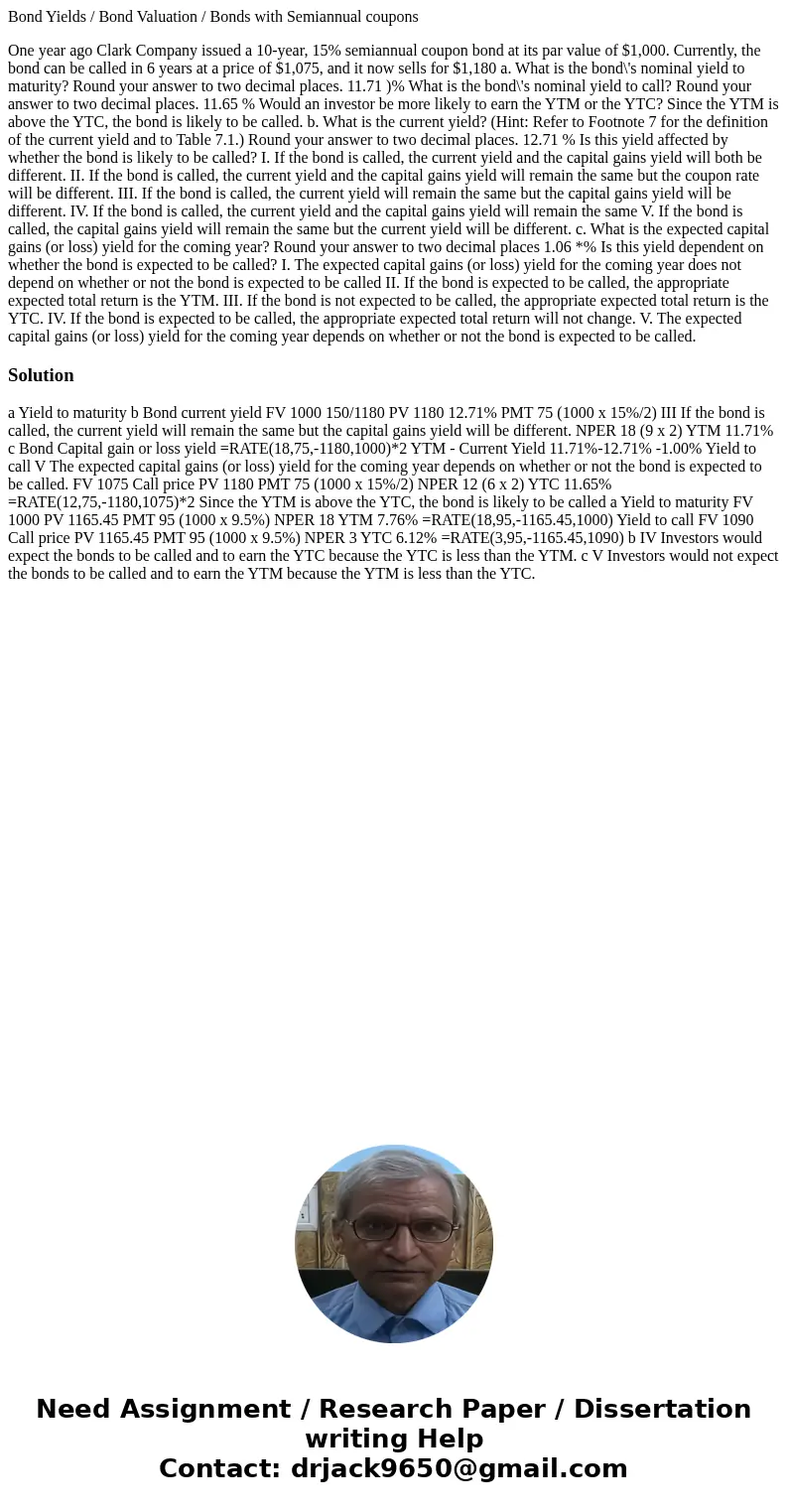Bond Yields Bond Valuation Bonds with Semiannual coupons O
Bond Yields / Bond Valuation / Bonds with Semiannual coupons
One year ago Clark Company issued a 10-year, 15% semiannual coupon bond at its par value of $1,000. Currently, the bond can be called in 6 years at a price of $1,075, and it now sells for $1,180 a. What is the bond\'s nominal yield to maturity? Round your answer to two decimal places. 11.71 )% What is the bond\'s nominal yield to call? Round your answer to two decimal places. 11.65 % Would an investor be more likely to earn the YTM or the YTC? Since the YTM is above the YTC, the bond is likely to be called. b. What is the current yield? (Hint: Refer to Footnote 7 for the definition of the current yield and to Table 7.1.) Round your answer to two decimal places. 12.71 % Is this yield affected by whether the bond is likely to be called? I. If the bond is called, the current yield and the capital gains yield will both be different. II. If the bond is called, the current yield and the capital gains yield will remain the same but the coupon rate will be different. III. If the bond is called, the current yield will remain the same but the capital gains yield will be different. IV. If the bond is called, the current yield and the capital gains yield will remain the same V. If the bond is called, the capital gains yield will remain the same but the current yield will be different. c. What is the expected capital gains (or loss) yield for the coming year? Round your answer to two decimal places 1.06 *% Is this yield dependent on whether the bond is expected to be called? I. The expected capital gains (or loss) yield for the coming year does not depend on whether or not the bond is expected to be called II. If the bond is expected to be called, the appropriate expected total return is the YTM. III. If the bond is not expected to be called, the appropriate expected total return is the YTC. IV. If the bond is expected to be called, the appropriate expected total return will not change. V. The expected capital gains (or loss) yield for the coming year depends on whether or not the bond is expected to be called.Solution
a Yield to maturity b Bond current yield FV 1000 150/1180 PV 1180 12.71% PMT 75 (1000 x 15%/2) III If the bond is called, the current yield will remain the same but the capital gains yield will be different. NPER 18 (9 x 2) YTM 11.71% c Bond Capital gain or loss yield =RATE(18,75,-1180,1000)*2 YTM - Current Yield 11.71%-12.71% -1.00% Yield to call V The expected capital gains (or loss) yield for the coming year depends on whether or not the bond is expected to be called. FV 1075 Call price PV 1180 PMT 75 (1000 x 15%/2) NPER 12 (6 x 2) YTC 11.65% =RATE(12,75,-1180,1075)*2 Since the YTM is above the YTC, the bond is likely to be called a Yield to maturity FV 1000 PV 1165.45 PMT 95 (1000 x 9.5%) NPER 18 YTM 7.76% =RATE(18,95,-1165.45,1000) Yield to call FV 1090 Call price PV 1165.45 PMT 95 (1000 x 9.5%) NPER 3 YTC 6.12% =RATE(3,95,-1165.45,1090) b IV Investors would expect the bonds to be called and to earn the YTC because the YTC is less than the YTM. c V Investors would not expect the bonds to be called and to earn the YTM because the YTM is less than the YTC.
 Homework Sourse
Homework Sourse